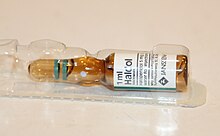| Neuroleptic malignant syndrome | |
|---|---|
 | |
| Haloperidol, a known cause of NMS | |
| Specialty | Critical care medicine, neurology, psychiatry |
| Symptoms | High fever, confusion, rigid muscles, variable blood pressure, sweating[1] |
| Complications | Rhabdomyolysis, high blood potassium, kidney failure, seizures[1][2] |
| Usual onset | Within a few weeks or days[3] |
| Causes | Antipsychotic medication[1] |
| Risk factors | Dehydration, agitation, catatonia[4] |
| Diagnostic method | Based on symptoms in someone who has started on antipsychotics within the last month[2] |
| Differential diagnosis | Heat stroke, malignant hyperthermia, serotonin syndrome, lethal catatonia[2] |
| Treatment | Stopping the offending medication, rapid cooling, starting other medications[2] |
| Medication | Dantrolene, bromocriptine, diazepam[2] |
| Prognosis | 10–15% risk of death[4] |
| Frequency | 15 per 100,000 per year (on neuroleptics)[1] |
Neuroleptic malignant syndrome (NMS) is a rare[5][6] but life-threatening reaction that can occur in response to antipsychotics (neuroleptic) or other drugs that block the effects of dopamine.[1][7] Symptoms include high fever, confusion, rigid muscles, variable blood pressure, sweating, and fast heart rate.[1] Complications may include muscle breakdown (rhabdomyolysis), high blood potassium, kidney failure, or seizures.[1][2]
Any medications within the family of antipsychotics can cause the condition, though typical antipsychotics appear to have a higher risk than atypicals,[1] specifically first generation antipsychotics like haloperidol.[5] Onset is often within a few weeks of starting the medication but can occur at any time.[1][3] Risk factors include dehydration, agitation, and catatonia.[4]
Rapidly decreasing the use of levodopa or other dopamine agonists, such as pramipexole, may also trigger the condition.[1][8] The underlying mechanism involves blockage of dopamine receptors.[1] Diagnosis is based on symptoms.[2]
Management includes stopping the triggering medication, rapid cooling, and starting other medications.[2] Medications used include dantrolene, bromocriptine, and diazepam.[2] The risk of death among those affected is about 10%.[4] Rapid diagnosis and treatment is required to improve outcomes.[1] Many people can eventually be restarted on a lower dose of antipsychotic.[2][3]
As of 2011, among those in psychiatric hospitals on antipsychotics about 15 per 100,000 are affected per year (0.015%).[1] In the second half of the 20th century rates were over 100 times higher at about 2% (2,000 per 100,000).[1] Males appear to be more often affected than females.[1] The condition was first described in 1956.[1]
- ^ a b c d e f g h i j k l m n o p Berman, Brian D. (January 2011). "Neuroleptic malignant syndrome: a review for neurohospitalists". The Neurohospitalist. 1 (1). New York City: SAGE Publications: 41–47. doi:10.1177/1941875210386491. PMC 3726098. PMID 23983836.
- ^ a b c d e f g h i j "Neuroleptic Malignant Syndrome". NORD (National Organization for Rare Disorders). 2004. Archived from the original on 19 February 2017. Retrieved 1 July 2017.
- ^ a b c "Neuroleptic Malignant Syndrome Information Page". Bethesda, Maryland: National Institute of Neurological Disorders and Stroke. Archived from the original on 4 July 2017. Retrieved 1 July 2017.
- ^ a b c d Strawn JR, Keck PE, Caroff SN (June 2007). "Neuroleptic malignant syndrome". The American Journal of Psychiatry. 164 (6): 870–876. doi:10.1176/ajp.2007.164.6.870. PMID 17541044.
- ^ a b New, Andrea M.; Nelson, Sarah; Leung, Jonathan G. (October 1, 2015). "Psychiatric Emergencies in the Intensive Care Unit". AACN Advanced Critical Care. 26 (4). Aliso Viejo, California: American Association of Critical-Care Nurses: 285–293. doi:10.4037/NCI.0000000000000104. PMID 26484986.
- ^ Troller, Julian N.; Chen, Xiaohua; Sachdev, Perminder S. (February 2009). "Neuroleptic malignant syndrome associated with atypical antipsychotic drugs". CNS Drugs. 23 (6). New York City: Springer Nature: 477–92. doi:10.2165/00023210-200923060-00003. PMID 19480467. S2CID 43859486.
- ^ Cite error: The named reference
Wijdicks 2024was invoked but never defined (see the help page). - ^ Sahin, Aynur; Cicek, Mustafa; Cekic, Ozgen Gonenc; Gunaydin, Mucahit; Aykut, Demet Saglam; Tatli, Ozgur; Karaca, Yunus; Arici, Mualla Aylin (December 2017). "A retrospective analysis of cases with neuroleptic malignant syndrome and an evaluation of risk factors for mortality". Turkish Journal of Emergency Medicine. 17 (4). Ankara, Turkey: Emergency Medicine Association of Turkey: 141–145. doi:10.1016/j.tjem.2017.10.001. PMC 5812912. PMID 29464217.